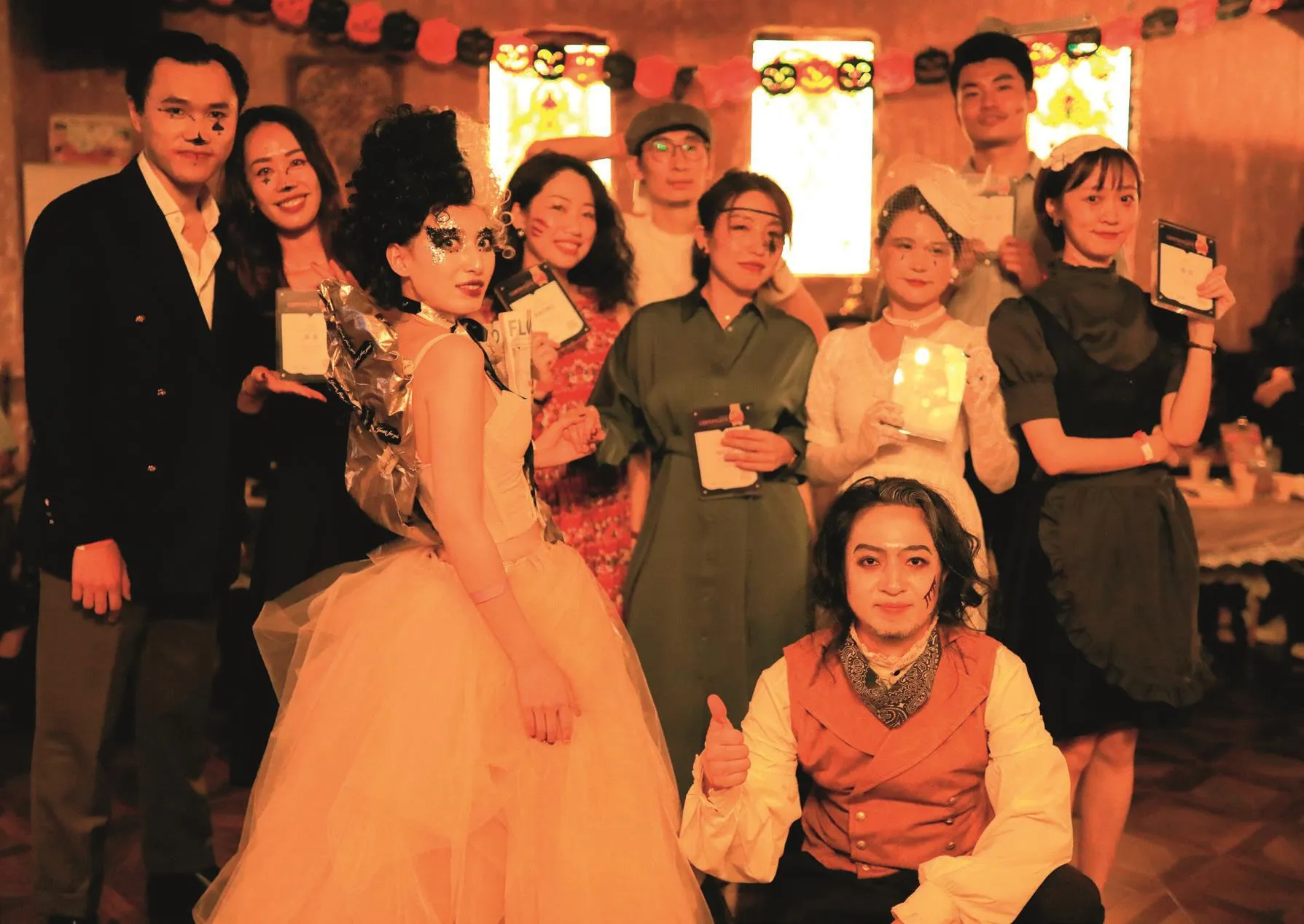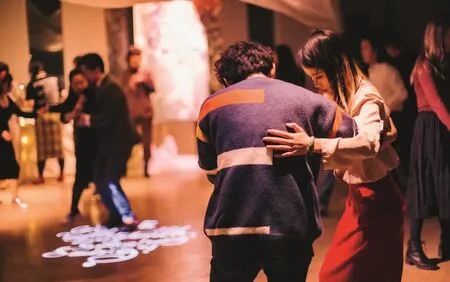Old Is Gold
By Kerina Kao
Cover image courtesy of Molly Sun
From swing dance to 1920s fashion, cultures from a bygone era are making a comeback in China—not just in the big cities
从摇摆舞到古着, 中小城市正掀起一阵复古潮

On a Saturday night in an industrial city in central China, a group of 30 youngsters in a bar are doing their best to recreateThe Great Gatsby.Leather shoes tap and fringed flapper dresses sway in time to the rhythm of 1920s American jazz music while Lü Dongyuan, the event’s organizer, sweeps hesitant newcomers onto the dance floor.
Lü founded Swing Zhengzhou, the first and only swing dance community in his hometown, the capital of Henan province, in June 2021.He moved back home due to the Covid-19 pandemic after five years of living in Beijing, where he first experienced swing culture, and hoped to start an organization that allowed him to keep dancing.A test swing lesson Lü organized in 2020, advertised only on his personal WeChat account and by the bar that hosted the event, drew 13 people, though only two of them are still coming to the dance socials today.“When young people in Zhengzhou get bored, they go for foot massages; dancing isn’t as fun as eating out,” he quips.
Molly Sun is another resident of one of China’s smaller cities who is trying to pursue a niche interest with roots in the past.She owns a brick-and-mortar shop, Molly’s Vintage,that sells vintage items from the 1920s to ’80s in Qingdao, a city in eastern Shandong province famous for its beer festival and sea views.Born and raised in Qingdao, Sun started her entrepreneurial journey by selling at markets in larger cities like Chengdu and Tianjin, and on online platforms like WeChat and Xiaohongshu, where a lot of her items are still being sold today to buyers in China’s “first-tier” cities.“Qingdao locals only make up about 20 percent of my customers,”she estimates.“It might be challenging for ordinary workers to adopt these fashions.”
Swing dance, a category of dances to a style of jazz music that originated in African-American communities in the 1920s, was first introduced to China by a Chinese-American, Adam Lee,in 2003, according to an article by dance organization Swing Beijing.

A Halloween-themed event organized by Amoy Swing (courtesy of Cao Mengda)
On the other hand, vintage clothing in China,orguzhuo(古着, “old wearables”), has more in common with Japanese vintage culture, which became widespread during World War II in Japan.During economic recessions, people became more price-conscious and started buying second-hand products from America to express their admiration for American culture.Sanlian Lifeweek magazine identifies the 1990s as when vintage fashion entered China, also via Beijing, when a collector named Li Yong opened a shop in the historical hutong district of the city.
A passion for retro
In China, the pandemic seems to have boosted the interest in “retro”—an umbrella term for cultural trends that reproduce trends of earlier eras—at least according to social media.By May 2023, search numbers related to “swing dance” andguzhuohad reached 2 million and 2.4 billion respectively on popular lifestyle platform Xiaohongshu and short-video platform Douyin.“Since 2021, I have noticed that customers have become more specific in describing the particular styles they are looking for.For example, many people come to my shop asking for styles fromThe Great GatsbyorThe Marvelous Mrs.Maisel, although they may not fully understand the connection between those styles and their eras,” says Sun.

Zhang and Huan are both fans of vintage motorcycles, and have many items allowing customers to experience this hobby in their Zhengzhou shop (courtesy of Toxic Waste)
Similarly, swing dancing, which overlaps with the vintage fashion community, has grown in popularity in the last five years, partly owing to social media and young enthusiasts like Lü, who moved out of China’s first-tier cities during the pandemic.Allen Li, a swing dance organizer and tattooist in Ningbo on China’s east-central coast, estimates around 20 cities in China now have their own swing dance organizations.Besides Ningbo, they range from Dali in the southwest, to Xi’an in the northwest, to Wuhan and Zhengzhou in central China, but many encounter challenges like not being able to find a permanent venue or to get locals interested enough to take classes beyond the basic levels.
When Braith Zhang and Siri Huan launched their vintage shop, Toxic Waste, in Zhengzhou in 2018, their focus was on curatingameikaji—American casual style mixed with Japanese style—pieces spanning from the 1940s to the 2000s.They encountered their fair share of consumers who were unfamiliar with the culture and resistant toward it.“In 2018, many people would come to our shop and ask,‘Were these clothes worn by dead people?’” Zhang recalls.
He believes the lack of knowledge about vintage culture created a chaotic market environment, as other business owners imitated their retro interior design but sold items made in Chinese factories that were too flawed or disqualified from export, which caused people new to vintage to believe that“vintage is merely leftover products with low quality and low value.”
The growing interest in the retro market is a double-edged sword, believes Cao Mengda,founder of both Mystery Vintage shop and Amoy Swing in Xiamen, a coastal city in Fujian province.“These days, people have more demands with regard to vintage items.They want it to be authentic, but also without flaws, and that’s a contradiction,” she says.“There is still only a small number of people who can accept the wear-and-tear of time on vintage items.”
Cao also feels that social media has driven up the price of many items: “The Laura Ashley and Gunne Sax items have tripled in price since I first started selling them [in 2016]…[some customers] are buying them for the brand,not because they understand the value of the item.” Similarly, Zhang, in Zhengzhou, stopped selling Carhartt items in 2021 after prices had doubled, as he felt the mania for brand names is no longer aligned with the “true essence” of buying vintage.
The willingness of consumers to pay for authentic vintage items may not match the online hype, either, especially in smaller cities where people feel more pressure to conform.“Many people perceive vintage products as unsuitable for daily life.They are hesitant to draw attention to themselves by dressing up in vintage clothing and walking on the streets,” says Cao.Zhang agrees: “My main clients are retro motorbike enthusiasts—a bold group of individuals who are unafraid to stand out, have disposable income, and are willing to invest in retro culture.”
Hua Mingye, organizer of Swing Xi’an in the capital of Shaanxi province, feels locals,especially men, have more conservative attitudes when it comes to dancing.“Swing dance is a social activity that requires courage to perform in front of others; whereas with Ultimate Frisbee, you just have to run, or with [watching]crosstalk comedy, you just have to laugh,” he says.“There is a natural barrier of entry to swing dance.”

A typical dance social organized by Swing Xi’an attracts up to 35 dancers (courtesy of Swing Xi’an)
In addition, compared to big metropolises,Hua feels like the lack of diversity prevents more people from embracing swing dance as a leisure activity.“[In a city where] there are lots of non-locals, people need friends, so they will actively seek out social activities.But Xi’an is a west-central city that attracts migrants from the nearby regions…who might go back to their hometowns on the weekend, or whose families might visit them.”
Because it’s hard to make a living from teaching swing dance alone, Hua is now working on an internet startup with friends.“Ultimately,Xi’an’s acceptance of outside cultures is limited.”
“Being the pioneers in a small city has its advantages.”
Niche communities
But there are advantages to being in smaller cities.One is the stronger sense of community,particularly across the various retro subcultures.Every weekend, Cao converts the coffee area on the first floor of her shop, Mystery Vintage,into a dance floor for Amoy Swing, and it serves as a gathering place for different types of retro enthusiasts as well as commercial collaborators seeking inspiration for retro-themed events.
Zhang and Huan appreciate the strong networking opportunities in their city.“Being the pioneers in a small city has its advantages,”says Zhang.“Our shop has been invited to participate in various events in Zhengzhou, such as street markets organized by local property developers to attract younger generations,music festivals, photography studios, as well as the Immortal Fire Fair, a famous art exhibition in Zhengzhou.”
In Zhengzhou’s dancing community, also,Lü is pleasantly surprised at how many people continue reaching out to him, though he has never advertised his organization much.“When I first founded Swing Zhengzhou, my primary goal was just to introduce swing culture to Zhengzhou.But the growing number of people trying to improve their skills for competitions or seek the thrill of dancing in other cities has motivated me to raise the level of swing dancers in Zhengzhou,”he says.There are other advantages to being in a smaller city like less competition, lower overhead costs, stronger bonds within the retro community,and being nearer to friends and family—Sun, in Qingdao, says her mother helped her run Molly’s Vintage when she first got started, and Lü had also moved back to Zhengzhou to spend more time with his family.
Sun now feels a sense of accomplishment in having influenced the lifestyle and culture of her hometown.“My shop attracted visits from vintage coffee shop owners and hostel owners during its construction.Since vintage items…in Qingdao are relatively niche, individuals who embraced the same lifestyle and interests quickly took notice of our shop, leading to strong friendships,” she says.“Some of the vintage shop owners in Qingdao were previously my customers.It brings me joy to see anyone develop an affinity for retro culture as a result of my efforts.”

